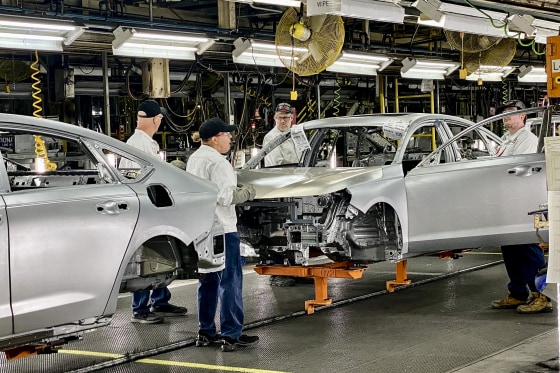
Maryville, OhioOhio is a historically unique location for the 75-year-old Japanese carmaker to begin production of its next generation.
Honda is currently working on more than $1 billion in fresh investments in the state, which were increased on Wednesday from the $700 million that was first disclosed. The installation of six giga presses—which Tesla made famous—and a new cell manufacturing technology for its future electric vehicle battery casings are the two most notable upgrades.
The centerpiece of Honda’s worldwide manufacturing activities will be the company’s developing EV hub in Ohio, which includes a separate $3.5 billion battery plant. During a daylong tour of the facilities, authorities stated that the Marysville Auto Plant can produce conventional cars, hybrids, and electric vehicles on the same assembly line.
According to Mike Fischer, North American lead for Honda’s battery-electric vehicle initiatives, the Ohio Honda EV center is setting the global standard for EV production for people, technology, and procedures. This is the footprint and characteristic performance that will be employed as we increase EV production on a regional and worldwide scale.
According to business officials, such significant manufacturing adjustments would normally start in Honda’s native Japan before being implemented at plants in the United States and other countries.
The Biden administration’s campaign for onshore manufacturing included the initial announcement of the Ohio investments in October 2022. They continue to be significant despite President Donald Trump’s promises of raising tariffs on imported goods like cars.
In 2024, Honda’s five U.S. assembly factories produced over a million cars. The remaining percentage was exported, with about 64 percent being sold in the United States. Mexico is home to one of its assembly plants.
When finished, Honda’s Marysville facility, outside of Columbus in central Ohio, will be able to produce about 220,000 cars a year. Currently, a number of Honda and Acura automobiles are built in the 4 million-square-foot complex. Later this year, an all-electric Acura RSX crossover, Honda’s first EV, is anticipated to join the lineup.
Compared to other manufacturers, the Japanese manufacturer was a latecomer to the electric vehicle market. Currently, it sells two all-electric crossovers in the United States: the Acura ZDX and the Honda Prologue. However, General Motors makes those cars in Mexico.
The Honda 0 SUV and Honda 0 Saloon EV concepts, which the firm unveiled at CES in Las Vegas last month, will come after the new Acura crossover.
Honda’s engine complex in Anna, Ohio, which grew from a modest rectangle structure in 1985 to a more than 2.8-million-square-foot plant, is the company’s largest engine facility worldwide and will make the aluminum battery packs for the new EVs.
“This large aluminum production technology is being established for all Hondas,” stated Tim Stroh, project leader for EV battery cases. Rolling that out to other products and other aspects worldwide is the aim here.
The business is setting up six enormous, 6,000-ton high-pressure die cast machines that will megacast, or gigacast, materials as Tesla has called them, in order to manufacture the battery packs and other EV components, as well as maybe engines in the future. The giant machines, which are about the size of a small house, produce pieces by applying a tremendous amount of pressure. In Ohio, Honda presses can currently handle 3,500 tons.
According to S&P Global Mobility, gigacasting has the potential to reduce manufacturing costs per unit by casting a single module instead of welding dozens of body pieces.
Before being employed in the final assembly of EVs, the packs will be transported from Anna to Marysville and other sites to be fitted with battery cells from Honda’s joint venture operations with LG Energy Solution.
Honda is establishing over 60 flexible manufacturing cells, or zones, for the battery assembly in Marysville in order to integrate the battery cells and packs. The new production process runs parallel to the main line in zones that ensure any potential slowdowns or issues don’t affect the main line, as opposed to a typical assembly line where pieces are placed as a vehicle travels.
According to Bob Schwyn, senior vice president of Honda Development and Manufacturing of America, this is regarded as Honda’s second founding. We’re taking advantage of the chance to reinvent how we manufacture things.
Honda has referred to its shift to fuel cell-powered electric vehicles as its “second founding.” The corporation continues to pursue its previously stated objective of attaining zero environmental impact by 2050 through three crucial action areas: carbon neutrality, clean energy, and resource rotation, despite the U.S. adoption of EVs being slower than anticipated.
One of those objectives is to sell only zero-emission automobiles by 2040. In recent years, numerous other automakers have postponed or dropped similar goals.
Utilizing a unique type of structural aluminum for the EV battery packs that can be recycled and reused is one of the new production methods and procedures to reduce emissions and waste that are part of the more than $1 billion investments in existing Ohio plants.
According to Schwyn, we’re taking advantage of the chance to reinvent how we manufacture things and add new value in the field of environmental responsibility. This includes methods for recovering our goods at the end of their useful lives and recycling or reusing all of the materials, particularly the limited resources for EV batteries, which effectively turn used Hondas into new ones.
More from CNBC:
-
Trump s tariffs could threaten Hollywood production, box office recovery
-
Ontario premier says he s ripping up $100 million contract with Musk s Starlink in response to U.S. tariffs
-
New York City office demand is finally back to normal
